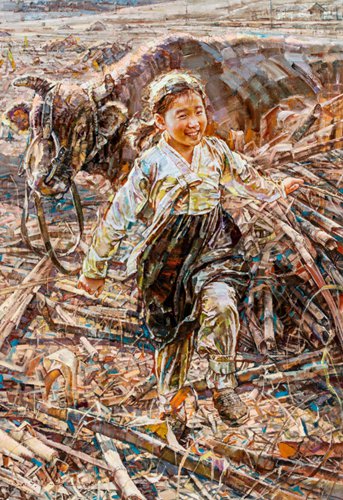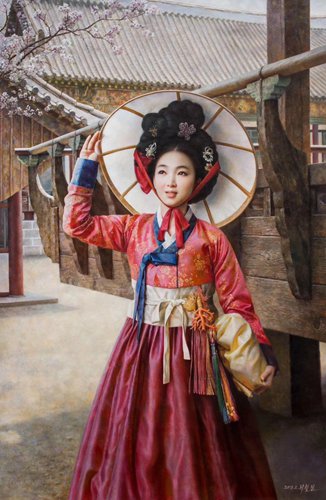HOME >> ARTS
North Korean painting continues to flourish in China
By Chen Xi Source:Global Times Published: 2019/7/24 17:03:40

Happiness by Han Il Photo: Courtesy of the Jinzhao Art Museum

The Season of Peach Blossom by Ri Zhe-jin Photo: Courtesy of the Jinzhao Art Museum
In a field full of straw, a little girl with a ponytail wearing a Korean-style dress looks into the distance, her smile like sunshine. Behind her, a cow is chewing on some food as it looks in the same direction with its cold eyes.
"In this commercial society, it is so rare to see such a simple and unvarnished painting," Gu Xinxia, one employee of the Contemporary Korean Oil Painting Exhibition, told the Global Times.
The exhibition, which kicked off on July 13 and will be held until August 12, is being held at the Greenland Binfen City shopping mall in Beijing's Daxing district by the Jinzhao Art Museum in Dandong, Northeast China's Liaoning Province.
Unique characteristics
"North Korean paintings are not commercialized due to the country's planned economy system, so artists can fully immerse themselves in art creation and make very pure art works rather than being tempted by commercial interests," Hu Yaozhong, the curator with the Jinzhao Art Museum, told the Global Times.
Hu explained that North Korean painters have a very strict grading system that ranges from the first grade (the highest level) to the sixth grade. To become a sixth grade level painter, an artist must go to a university to studying painting for seven years and then pass the exams. Promotions to subsequent grades usually come every two years. Artists in North Korea enjoy a very stable income but do not have the rights to sell their artworks, which can only be sold by art studios like the Mansudae Art Studio, one of the largest centers of art production in North Korea.
Three generations
Bao Guitao, an art critic, told the Global Times that artists in North Korea can be roughly divided into three generations.
The first generation of artists is made up of those who studied in Japan in the early 20th century. They had wide international vision and paid close attention to the international art trends of the time.
The second generation, artists after 1953, shared similar backgrounds with the first generation as they too studied in Japan. Some of them adhered to their artistic ideals and maintained a certain distance from mainstream ideology. For example, painter Hong Tian-xing is famous for his impressionist works. Compared with Western works of impressionism, Hong liked to add natural scenery featuring North Korean elements in his works.
The third generation, the artists of today, have their own understanding of certain Western art schools, and are fascinated with impressionist art. They are interested in the personalization of artistic expression and the creativity of artistic language.
Choi Yu-jun, a master of figure painting belonging to the third generation, is really good at using soft colors. In one painting at the exhibition, he uses these colors to depict a courtesan wearing traditional Korean clothing sleeping on a tiger skin chair. Her clothes are embroidered with red peonies representing wealth, and the tiger skin represents power. Looked at from a distance, the painting looks like a very vivid photo.
"We highly recommended the painter Han Il, whose style is very different from other painters. The subject matter he mainly expresses is the commonality of human nature. Almost all of his works are about children. When you look at his works, you will be touched by the children's innocent faces and smiles," Gu said, noting that a price cannot be put on this type of artistic value.
Another interesting painter is Kim Kui-gang, who loves to depict the world from the viewpoint of children. In one painting at the exhibition, chickens are as big as full-grown men and all the roofs of the houses are covered in red chili peppers and corn drying in the sun - a very typical scene in North Korea. Gu said that Jin's painting is very special because he first applies paint to the canvas and then scrapes away the paint with a spatula to form a painting.
Rising popularity
According to Bao, a large number of Korean paintings were introduced into China during the 17th century, and many noble families, officials and the businessmen liked to give the painting as gifts. Over the centuries Korean paintings have remained popular and today sales of North Korean paintings continue to show a trend toward growth.
"Since North Korea's art market is still not very developed, modern and contemporary oil paintings are undervalued. The art in North Korea is like an untapped art gold mine with a huge potential for appreciation," Hu said, noting that many Chinese like to collect these artworks as investments.
"Compared with the high-priced oil painting in Western countries, the price of paintings in North Korea is very cheap. In China, the middle class can afford them. Many of them like to buy these original paintings to hang them on the wall of their living rooms," Gu said.
North Korea's artistic output is not only for economic demand, but also for cultural promotion.
The natural formation of a demand for North Korean paintings in China shows that the future of art from the country is bright.
"The present and future of North Korean art cannot be denied nor marginalized. North Korea will appear in every historical stage, telling its own story through various and special art works," Bao said.
Newspaper headline: Bright future